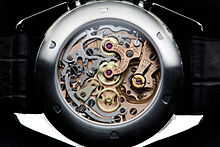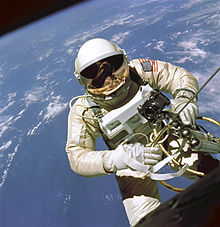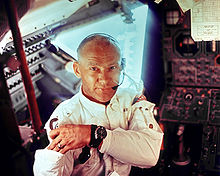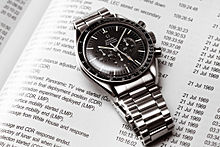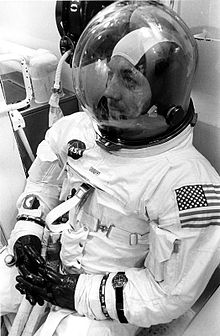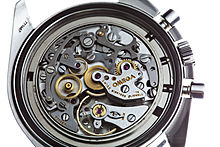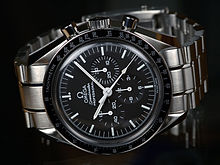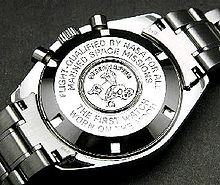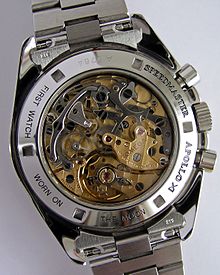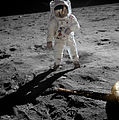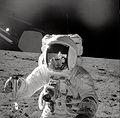- Omega Speedmaster
-
"Moonwatch" redirects here. For the science program, see Operation Moonwatch.
Omega Speedmaster 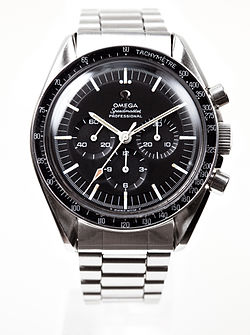
Omega Speedmaster Professional Ref. 145.012Manufacturer Omega Also called Moonwatch Introduced 1957 Movement Omega caliber 321, 861, 1861, others Omega Speedmaster is a brand of chronograph wristwatches produced by the Omega Watch Company. Many different watches have been marketed under the Speedmaster name over the years. The manual winding Speedmaster Professional or "Moonwatch" is the most well-known and longest-produced; it was worn during the first American spacewalk during Gemini 4 and was the first watch worn on the moon during Apollo 11.[1][2] The Speedmaster Professional remains one of several watches qualified by NASA for spaceflight and is still the only one so qualified for EVA.[3] The Speedmaster line also includes a multitude of other models, including analog-digital and automatic mechanical watches.[4][5]
Contents
Early development
The Speedmaster was not originally designed for space exploration. Instead, it was introduced in 1957 as a sports and racing chronograph, complementing Omega's position as the official timekeeper for the Olympic Games. [6][7] The first Speedmaster model, the reference CK 2915 was released in 1957. It was powered by the Omega Calibre 321, developed in 1946 by Albert Piguet of Lemania, which had been acquired in 1932 by Omega's parent company, SSIH. The "Speedmaster" name was coined from the model's novel tachymeter scale bezel (in brushed stainless steel) and by the convention set by prior Omega brands Seamaster and Railmaster.[6] The model established the series's hallmark 12-hour, triple-register chronograph layout, domed Plexiglas crystal, and simple, high-contrast index markers; but, unlike most subsequent Speedmaster models, it used Omega's Broadarrow hand set. In 1959, a second version, CK 2998, was released with a black aluminum tachymeter bezel and alpha hands. This was again updated in 1963 by references ST 105.003 with straight baton hands and ST 105.012 with an asymmetrical case to protect the chronograph pushers and crown.
Use in space
Qualification tests
Three years before the Speedmaster's official qualification, Wally Schirra took his personal CK 2998 aboard Mercury-Atlas 8 (Sigma 7) on October 3, 1962.[8] That same year, per an anecdote repeated by Omega press materials, trade publications, and NASA itself, a number of commercial chronograph wristwatches were furtively purchased from Corrigan's, a Houston jeweler, to evaluate their use for the Gemini and Apollo Programs.[8][9][6] James Ragan, a former NASA engineer responsible for Apollo flight hardware testing, has downplayed this story, calling it a "complete invention". Instead, bids were officially solicited of several brands already familiar to astronauts, including Breitling, Rolex, and Omega, as well as others that produced mechanical chronographs.[10][11] Hamilton submitted a pocket watch and was disqualified from consideration, leaving three contenders: Rolex, Longines-Wittnauer, and Omega. These watches were subjected to tests under extreme conditions:
- High temperature: 48 hours at 71° C followed by 30 minutes at 93° C
- Low temperature: Four hours at -18° C
- Temperature cycling in near-vacuum: Fifteen cycles of heating to 71° C for 45 minutes, followed by cooling to -18° C for 45 minutes at 10-6 atm
- Humidity: 250 hours at temperatures between 20° C and 71° C at relative humidity of 95%
- Oxygen environment: 100% oxygen at 0.35 atm and 71° C for 48 hours
- Shock: Six 11ms 40 G shocks from different directions
- Linear acceleration: from 1 to 7.25G within 333 seconds
- Low pressure: 90 minutes at 10-6 atm at 71° C followed by 30 minutes at 93° C
- High pressure: 1.6 atm for one hour
- Vibration: three cycles of 30 minutes vibration varying from 5 to 2000hz with minimum 8.8G impulse
- Acoustic noise: 30 minutes at 130db from 40 to 10,000hz [9][6]
All chronographs tested were mechanical hand-wind models since neither the first automatic chronograph nor the first quartz watch would be available until 1969. The evaluation concluded in March 1965 with the selection of the Speedmaster, which survived the tests while remaining largely within 5 seconds per day rate. [8][6][10][12]
Gemini program
Gus Grissom and John Young wore the first officially qualified Speedmasters on Gemini 3 on March 23 1965. Several months later, Ed White made the first American space walk during Gemini 4 with a Speedmaster 105.003 strapped to the outside of the left-side sleeve of his G4C space suit.[8] In order to accommodate the space suit, the watch was attached via a long nylon strap secured with Velcro. When worn on the wrist, the strap could be wound around several times to shorten its length.[8] According to Omega, the company was surprised to learn of the Speedmaster’s role upon seeing a photograph of the EVA; however, ordering forms sent by NASA's Gemini 4 Flight Support Procurement Office to Omega's American agents in 1964 suggest that this anecdote may be exaggerated.[6] These images would be widely used in Omega marketing materials from 1965-1967, establishing the popular connection between the Speedmaster and space exploration.[13][6] Speedmasters were issued to all subsequent Gemini crews until the end of the program in 1966.
Apollo program
To reinforce the association with astronauts, Omega also began using the "Professional" appellation for existing Speedmaster models after Gemini 4. In 1966, Speedmaster reference 105.012 was updated to reference 145.012. These two models would be the two Speedmaster references known to have been worn on the moon by Apollo astronauts, the original "moonwatches."[8] Speedmasters were used throughout the early manned Apollo program, and reached the moon with Apollo 11. Ironically, these and prior models are informally known as "Pre-moon" Speedmasters, since their manufacture predate the moon landings and lack the inscription subsequent models carry: "The First and Only Watch Worn on the Moon".
Although Apollo 11 commander Neil Armstrong was first to set foot on the moon, he left his 105.012 Speedmaster inside the Lunar Module as a backup because the LM's electronic timer had malfunctioned.[14] Buzz Aldrin elected to wear his and so his Speedmaster became the first watch to be worn on the moon. Later, he wrote of his decision:
"It was optional to wear while we were walking on the surface of the moon ... few things are less necessary when walking around on the moon than knowing what time it is in Houston, Texas. Nonetheless, being a watch guy, I decided to strap the Speedmaster onto my right wrist around the outside of my bulky spacesuit." [14]
Aldrin's Speedmaster was lost during shipping when he sent it to the Smithsonian Institute; the reference number of the watch is not known for certain, though it is sometimes reported as a 145.012.[8] Speedmasters were carried by the crews of all subsequent Apollo missions, including American members of the Apollo-Soyuz Test Project (Soviet crew wore Omega Flightmasters).[8][15]
In 1970, after Apollo 13 was crippled by the rupture of a Service Module oxygen tank, Jack Swigert's Speedmaster was famously used to precisely time the critical 14-second Mid-Course Correction 7 burn using the Lunar Module's Reaction Control System, which allowed for the crew's safe return.[16][17] In recognition of this, Omega was awarded the Snoopy Award by the Apollo 13 astronauts, "for dedication, professionalism, and outstanding contributions in support of the first United States Manned Lunar Landing Project."[18][19]
In 1971, Apollo 15 commander David Scott's issued Speedmaster lost its Plexiglas crystal during EVA-2. For EVA-3, the final lunar surface EVA, he wore a Waltham chronograph watch that he had agreed to evaluate for the company.[20][21] Because of the commercial interests involved and the revelation of the Apollo 15 postage stamp incident, NASA withheld Waltham's name for years afterward. Therefore, while the Speedmaster was the first watch worn on the moon, it is not the only one, as Omega often claims on its watches and in marketing materials.
In addition to issued crew watches, Apollo 17 carried an additional Speedmaster to lunar orbit as part of the Heat Flow and Convection Experiment conducted by Command Module pilot Ronald Evans.[22][23] This watch was sold for $23,000 at a Heritage Auction in 2009. [24]
Later models
In 1968, American insurance salesman Ralph Plaisted and three companions were the first confirmed expedition to reach the north pole by land on snowmobiles. The team successfully used the same reference 145.012 Omega Speedmasters as the Apollo program along with sextants for navigation.[25]
Also in 1968, Omega transitioned the caliber 321 movement to the new caliber 861, also designed by Albert Piguet, with the introduction of the reference 145.022 Speedmaster. The 861 was very similar to the 321, but replaced its column wheel switching mechanism with a cam and increased the beat rate from 18000 to 21600 vibrations per hour. Most Speedmaster Professional watches from 1968 to the present have used variants of this movement, including the modern rhodium-plated caliber 1861 and decorated exhibition calibers 863 and 1863. A standard Speedmaster Professional model with Plexiglas crystal, solid caseback with anti-vibration and anti-magnetic dust cover, tachymeter scale, without date or day complications, and powered by a caliber 861-based movement has been continuously produced since. The tritium-powered phosphorescent lume on the hands and index markers of the original watches were replaced in the 1990s with non-radioactive pigments, but the fundamental design, dimensions, and mechanism of these watches have remained unchanged. In this form, the basic Speedmaster line has remained flight-qualified for NASA space missions and EVAs, after re-evaluation by NASA in 1972 and for use in the Space Shuttle program in 1978. [15] The current such model is reference 3570.50.
Omega has produced a large number of commemorative and limited edition variants of the basic "moonwatch" design, celebrating important anniversaries and events, emblazoned with the different patches for the space missions it was issued for, or evoking its motor sport roots with various racing patterns. It has also released many models made with various precious metals, jewels, and alternative dial colors for the luxury market.[26]
Over the years, Omega has also sought to improve functional aspects of the basic Speedmaster Professional. In 1969, it produced the Speedmaster Professional Mk II, with shrouded lugs and a flat, anti-reflective mineral glass crystal. In 1970, Omega launched the Alaska Project under Pierre Chopard, which changed the dial of the original Speedmaster Professional from black to white and created a removable anodized aluminum housing to shield the watch from a wider range of temperatures.[27] In 1971 and 1973, Omega turned to automatic mechanisms the Speedmaster Automatic MkIII and MkIV models. None of these proved as popular or long-lasting as the basic Speedmaster Professional "moonwatch", however. A variety of other types of watches have used the Speedmaster brand, including many different automatic day and day-date models, the tuning fork movement Speedsonic line, and the digital LCD Speedmaster Quartz. The digital-analog Speedmaster X-33 was produced in 1998; it was qualified for space missions by NASA and flown on the Mir space station and Space Shuttle Columbia during STS-90 later that year.
Gallery
See also
- Science and technology in Switzerland
- Waltham watch on the moon
- Swiss Space Office
References
- ^ NELSON, A. A. (1993). "The moon watch: a history of the Omega Speedmaster Professional". Bulletin of the National Association of Watch and Clock Collectors 35 (282): 33–38.
- ^ Aldrin, Buzz. Magnificent Desolation. pp. 260–261. ISBN 978-0307463463.
- ^ "Omega Watches: Speedmaster History". Omega S.A.. http://www.omegawatches.com/spirit/pioneering/speedmaster-history. Retrieved 2011-02-09.
- ^ "Omega Watches: Speedmaster". Omega S.A.. http://www.omegawatches.com/gents/speedmaster. Retrieved 2011-02-09.
- ^ Richon, Marco (2007). A Journey Through Time. Omega Ltd. pp. 616, 638–639. ISBN 978-2-9700562-2-5.
- ^ a b c d e f g Richon, Marco (2007). A Journey Through Time. Omega Ltd. pp. 596–602. ISBN 978-2-9700562-2-5.
- ^ Kessler, Ken (2009). "Space Age". Omega Lifetime 4: 30–36.
- ^ a b c d e f g h "Apollo Lunar Surface Journal: Omega Speedmaster Professional Chronographs". NASA. http://www.hq.nasa.gov/alsj/omega.html. Retrieved 2011-02-09.
- ^ a b "How the OMEGA Speedmaster became the Moonwatch". Press Release. OMEGA SA. 6 April 2009. http://www.omegawatches.com/press/press-kit-text/1122. Retrieved 9 May 2010.
- ^ a b "James H. Ragan: NASA's man behind the MoonWatch". Press Release. OMEGA SA. 21 July 2009. http://www.omegawatches.com/press/press-kit-text/1161. Retrieved 9 April 2011.
- ^ Linz, Alexander; James H. Ragan (2009-06). "How Omega Got to the Moon". Watch Time: 124–125. ""Once and for all: it never happened that way. That story s a complete invention.""
- ^ Linz, Alexander; James H. Ragan (2009-06). "How Omega Got to the Moon". Watch Time: 124–125. ""We conducted a number of rigorous tests and at the end of them all only Omega was left standing. Rolex failed primarily on account of the humidity test. Its watch’s hands became bent at high temperatures and got stuck. The crystal of the Longines watch got loose several times and the movement stopped working, too. The Speedmaster passed all the laboratory tests and exhibited the best reliability.""
- ^ "Omega Watches: Advertisement". Omega S.A.. http://www.omegawatches.com/spirit/hall-of-fame/advertisement. Retrieved 2011-02-09.
- ^ a b Aldrin, Buzz (1973). Return To Earth. Random House. ISBN 978-0394488325.
- ^ a b Richon, Marco (2007). A Journey Through Time. Omega Ltd. pp. 607, 614. ISBN 978-2-9700562-2-5.
- ^ "Mission Operations Report:: Apollo 13" (PDF). NASA-MSC Internal Report. NASA. 1970-04-28. pp. 10–2. http://www.hq.nasa.gov/alsj/a13/A13_MissionOpReport.pdf
- ^ Woodfill, Jerry (2010-04-16). "13 Things That Saved Apollo 13, Part 6: Navigating By the Earth's Terminator". Universe Today. http://www.universetoday.com/62763/13-things-that-saved-apollo-13-part-6-navigating-by-earths-terminator/. Retrieved 2011-02-09.
- ^ "Omega and Snoopy: Two Great Names in the History of Space Exploration". Omega S.A.. 2003-04-03. http://www.omegawatches.com/press/press-kit-text/267. Retrieved 2011-02-09.
- ^ Richon, Marco (2007). A Journey Through Time. Omega Ltd. pp. 607. ISBN 978-2-9700562-2-5.
- ^ "Apollo 15 Lunar Surface Journal: Preparations for EVA-2". NASA. 2008-11-22. http://www.history.nasa.gov/alsj/a15/a15.eva2prep.html. Retrieved 2011-02-10.
- ^ "Mission Operations Report:: Apollo 13". NASA News Release 72-189. 1972-09-15. http://www.collectspace.com/resources/flown_a15_articlescarried.html
- ^ "Experiment: Heat Flow and Convection". NASA. http://ares.jsc.nasa.gov/HumanExplore/Exploration/EXlibrary/docs/ApolloCat/Part2/HFEA14.htm. Retrieved 2011-02-10.
- ^ "Apollo 17 Heat Flow and Convection Experiments" (PDF). NASA Technical Memorandum. NASA. 1973-07-16. http://ntrs.larc.nasa.gov/search.jsp?R=53269&id=3&as=false?=false&qs=Ns%3DArchiveName%257c0%26N%3D4294957086
- ^ "Apollo 17 Flown Omega Stainless Steel Speedmaster Professional Watch". Heritage Auctions. http://historical.ha.com/common/view_item.php?Sale_No=6022&Lot_No=41028. Retrieved 2011-02-09.
- ^ Richon, Marco (2007). A Journey Through Time. Omega Ltd. pp. 603. ISBN 978-2-9700562-2-5.
- ^ Richon, Marco (2007). A Journey Through Time. Omega Ltd. pp. 598–670. ISBN 978-2-9700562-2-5.
- ^ "An Interview with Pierre Chopard, Leader of the Omega Speedmaster Alaska Project". Hodnikee. 2011-01-27. http://www.hodinkee.com/blog/2011/1/27/exclusive-an-interview-with-pierre-chopard-leader-of-the-ome.html. Retrieved 2011-02-09.
External links
- History of the Omega Speedmaster, a detailed table of Speedmaster models
- Omega Speedmaster Professional Chronographs, NASA History page.
- speedmaster-mission.net, by Jean-Michel
- Do It Yourself NASA Velcro StrapPDF (2.77 MB)
- Omega
- The Right Stuff: Inside the Omega Speedmaster Professional - Part 1, by Jack Forster
- The Right Stuff: Inside the Omega Speedmaster Professional - Part 2, by Jack Forster
Categories:- Watches (specific model)
- 1957 introductions
Wikimedia Foundation. 2010.

